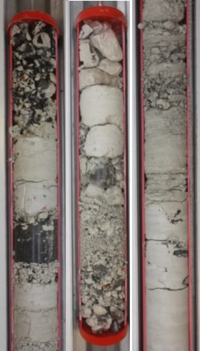Geology and properties of limestone
Geology and hydrogeology
In eastern Denmark, glacial tertiary (quaternary?) deposits (clay till, sand) are on top of the limestone aquifers. The uppermost limestone layer is typically a carbonated sand limestone (København Kalk), followed by bryozoan limestone. The carbonated sand limestone is rather evenly and horizontally layered and may contain flint layers and nodules. The bryozoan limestone, in contrast, typically has bank structures. A good description of the geologic stratification is given in the Report [1] (in Danish). Figure 1 shows the typical krono-, bio- and lithostratigraphy in eastern Zealand (Denmark) and Øresundsregion.
Limestone geologies are often heavily fractured and can include almost impermeable chert layers and nodules. Figure 2 shows come cores from boreholes from the Akacievej site, which illustrate the heterogeneity of the limestone there. In such fractured limestone geologies, flow predominantly occurs in the fractures due to a much higher hydraulic conductivity as in the limestone matrix, which typically has a very low hydraulic conductivity, but a relatively high porosity (10-40 Vol.-%). Limestone aquifers are typically anisotropic, which means that their horizontal hydraulic conductivity is higher than in the vertical direction. Especially vertical and subvertical fractures can have a major influence on the anisotropic behavior of limestone aquifers, because the flow happens predominantly along the fractures. Due to that, it is possible that the main flow cannot simply be identified from the head isolines, but the direction of the major fractures has to be considered.
The limestone found at the Akacievej site is a carbonated sand limestone (Copenhagen chalk) on top of a bryozoan limestone, both with a strongly varying hardness. Due to glacial activity, the uppermost 1-5 meters of the limestone are crushed.
Properties of limestone
The sorption behavior for chlorinated solvents on limestone was examined in Salzer (2013). For chlorinated solvents like PCE, sorption to limestone can be strong (kd values of 0.5-1 L/kg were observed). The following table gives an overview of values that were determined for the Akacievej site:
| Parameter | Value | Comment |
|---|---|---|
| K_crushed | 5x10^-4 m/s | crushed limestone conductivity |
| n_matrix | 0.10 - 0.20 | matrix porosity |
| Ap | 2 mm | typical fracture aperture |
| K_matrix | 1x10^-7 m/s | limestone conductivity |
| B | 20 - 25 m | aquifer thickness |
| D_m | 7.5x10^-7 m^2/s | effective diffusivity |
| k_d | 0.5-1.0 L/kg | sorption coefficient for PCE on limestone |
- ↑ Geo/Geus, Geologi, (Copenhagen, 2014)

